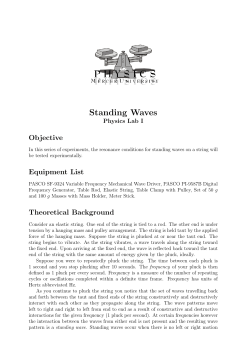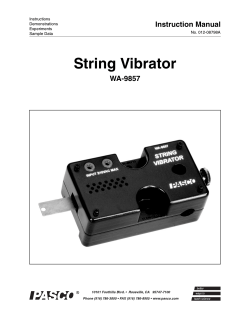
STANDING WAVES IN A STRETCHED STRING
Physics 31210 Spring 2006 Experiment 10 STANDING WAVES IN A STRETCHED STRING Introduction: Waves of many sorts are of considerable importance in physics. In this experiment you will study a particular type of mechanical wave behavior --- standing waves in a stretched string. Waves of the same amplitude, frequency and wavelength traveling in opposite directions will combine according to the principle of superposition to form STANDING WAVES. The frequency f and wavelength λ of the standing waves are related to the traveling wave speed V through the expression V = λf For traveling transverse waves in a stretched string, the wave speed is expected to be: V = F/µ where F is the tension in the string and µ is its linear density or mass per unit length. In this experiment, standing wave patterns will be produced in strings of known linear density under a measured (and adjustable) tension by a vibrator of known fixed frequency f = 120 Hz attached to one end of the string. The other end of the string passes over a pulley to a weight hanger on which you can place weights to adjust the tension F. The wavelength λ can be directly measured. For each case studied, the wave speed V could be calculated from measured quantities using each of the two equations given above and the two values could be compared. Additionally, the two equations can be combined to give a relation between the measured wavelength and tension in a string which depends only on the linear density µ of the string and the vibrator frequency f. We obtain the expression: f λ = F/µ . Rearranging yields Squaring this yields F = (f µ)λ . F = (f 2µ)λ2 . Thus a plot of measurements of F versus λ or a plot of F versus λ2 should yield a straight line with a slope which is a definite function of µ and f. You will use such plots to see if your measurements are consistent with the theoretical relationships. Equipment: Electric vibrator (120 Hz), pulley and supports, weight hanger and set of known weights, tape measure or meter stick, two strings of different known linear density, 2 sheets linear graph paper. 10-1 Physics 31210 Spring 2006 Experiment 10 Procedure: Attach one end of the lighter string to the arm of the vibrator. Pass the other end over the pulley and attach it to the weight hanger. Plug in the vibrator and vary the tension of the string by pulling down on the weight holder. At certain values of the tension the string will resonate at 120 Hz and you should see various standing wave patterns of the string in the fluorescent light of the room. (The fluorescent lights act as strobe lights for this purpose.) Observe the standing wave patterns and the way the wavelength changes as you change the tension. (The distance between adjacent nodes, i.e. points at which the string does not appear to move, is half a wavelength. Between each pair of adjacent nodes is an antinode, a place where the amplitude of the string motion is largest. The distance measured from node to node across as many loops as possible is the length of that number of HALF-waves.) Then proceed with the quantitative part of the experiment. Add weights to increase the tension in the string until it is vibrating in the fundamental mode or first harmonic (two nodes, one at each end of the string, with one antinode in the middle). Adjust the tension carefully until the standing wave has its maximum amplitude. Determine the wavelength λ for this standing wave pattern and estimate the error δλ in the wavelength. (In this case the uncertainty in your measurement of the length of the loop will be half the error in the wavelength.) (Note that the end of the vibrator may not be exactly a node; sometimes a distinct node can be seen at a little distance from the vibrator.) Record the value of the mass m = F/g producing the tension F and your estimate of the error δm in this mass. (You can estimate the error by adding or subtracting small weights and seeing how much difference in tension is required before you can tell that you no longer have maximum-amplitude standing waves.) Be sure to include the mass of the weight hanger. Now reduce the mass on the weight hanger and determine the values of the mass that produce standing wave patterns with increasing numbers of nodes. For each of 4 more standing wave patterns (second and higher harmonics), measure and record the wavelength and the mass m and the corresponding errors δλ and δm. (Note that for a given error in your length measurement you will have an error in the wavelength that depends on the number of halfwavelengths you have measured.) Replace the lighter string with the heavier one and repeat the same process, determining the wavelength and tension and their errors for 4 standing wave patterns. (You may not be able to put enough weights on the weight holder to obtain the fundamental mode. In this case your longest wavelength pattern will be the second harmonic.) Make sure you record µ and δµ for the strings you use. Analysis: First determine the range of traveling wave speeds for the waves you have observed. For the longest wavelength you have observed for either string, use your data for λ and the known frequency f to compute the traveling wave speed V. Compute the error δV using the rules of error propagation. Repeat the process for the shortest wavelength which you observed for either string. This gives you the range of wave speeds involved. Now calculate V and δV from your values for F and δF and the given values of µ and δµ in the same two cases. Compare the two values for V in each case. Are they consistent with each other? If not, can you think of any 10-2 Physics 31210 Spring 2006 Experiment 10 sources of error in your measurements that were not considered but that might lead to a disagreement in your results? Now make a plot of F as a function of λ for the lighter string. (This tends to spread the data points better than a plot of F versus λ2.) Use error bars on both the F and the λ values for your points. To do this you will have to use the rules of error propagation to calculate the error in F from the error in F. A straight line relationship between F and λ would be consistent with the relationship we worked out previously. On the plot, draw your "best fit" straight line and your two "worst-case" straight lines through the data. (See Ch. 5 of "Measurement and Error" to review the techniques.) Use the graph to determine the slope, f µ and the error in the slope. Also determine the intercept ( F for λ= 0) and the error in the intercept. Calculate µ and δµ from your results for the slope. (You may assume that f, the error in the frequency f is negligible.) Compare your result for with the given value of for that string. Are they consistent? Is the intercept consistent with what is expected? Repeat the graphical analysis using the data for the other string. Questions for the report: 1) Consider the range of traveling wave speeds you calculated in the first part of the analysis. Do the values seem reasonable to you for waves traveling in a string? Why? How do the speeds compare with other speeds for mechanical systems with which you are familiar? 2) Discuss, in your own words, the phenomenon of standing waves in a stretched string. How do you end up with waves traveling in opposite directions in the string when there is only one vibrator to start the motion? Why is the pulley end of the string a node? Give a general expression for the possible wavelengths for standing waves in a string of length L. 3) Discuss briefly some other systems in which one might be able to observe standing waves. NOTE: Before you leave the lab, you must have all of the required measurements of wavelength and tension for at least 5 standing wave modes in the lighter string and 4 standing wave modes in the heavier string. You must have estimates of errors for all of your measurements. Make sure you have recorded the linear densities (and their errors) for the strings you used. If you have time you may want to make some plots of your data to make sure your measurements look reasonable and that you understand the process. 10-3 Physics 31210 Spring 2006 Experiment 10 Standing Waves in a stretched String Table 1. Data for the light string mode mass m = F/g (kg) m (kg) wavelength λ (m) δλ (m) m (kg) wavelength λ (m) δλ (m) string mass density µ ± δµ = Table 2. Data for the heavy string mode mass m = F/g (kg) string mass density µ ± δµ = 10-4
© Copyright 2025





















